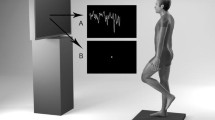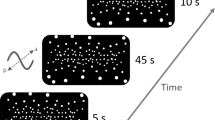Abstract
The link between visual information and postural control was investigated based on a multi-degree-of-freedom model using the framework of the uncontrolled manifold (UCM) hypothesis. The hypothesis was that because visual information specifies the position of the body in space, it would couple preferentially into those combinations of degrees of freedom (DOFs) that move the body in space and not into combinations of DOFs that do not move the body in space. Subjects stood quietly in a virtual reality cave for 4-min trials with or without a 0.2, 2.0 Hz, or combined 0.2 and 2.0 Hz visual field perturbation that was below perceptual threshold. Motion analysis was used to compute six sagittal plane joint angles. Variance across time of the angular motion was partitioned into (1) variance associated with motion of the body and (2) variance reflecting the use of flexible joint combinations that keep the anterior–posterior positions of the head (HDPOS) and center of mass (CMPOS) invariant. UCM analysis was performed in the frequency domain in order to link the sensory perturbation to each variance component at different frequencies. As predicted, variance related to motion of the body was selectively increased at the 0.2-Hz drive frequency but not at other frequencies of sway for both CMPOS and HDPOS. The dominant effect with the 2.0-Hz visual drive also was limited largely to variance related to motion of the body.




Similar content being viewed by others
References
Alexandrov AV, Frolov AA, Horak FB, Carlson-Kuhta P, Park S (2005) Feedback equilibrium control during human standing. Biol Cybern 93:309–322
Anastasio T, Patton P (2004) Analysis and modeling of multisensory enhancement in the deep superior colliculus. In: Calvert G, Spence C, Stein BE (eds) Handbook of multisensory processes. MIT Press, Boston
Barin K (1989) Evaluation of a generalized-model of human postural dynamics and control in hte sagittal plane. Biol Cybern 61:37–50
Bronstein AM, Hood JD, Gresty MA, Panagi C (1990) Visual control of balance in cerebellar and parkinsonian syndromes. Brain 113:767–779
Corriveau H, Hebert R, Raîche M, Dubois MF, Prince F (2004) Postural stability in the elderly: empirical confirmation of a theoretical model. Arch Gerontol Geriatr 39:163–177
Creath R, Kiemel T, Horak FB, Peterka RJ, Jeka JJ (2005) A unified view of quiet and perturbed stance: simultaneous co-existing excitable modes. Neurosci Lett 377:75–80
de Looze MP, Kingma I, Bussmann JBJ, Toussaint HM (1992) Validation of a dynamic linked segment model to calculate joint moments in lifting. Clin Biomech 7:161
Feldman AG, Levin MF (1995) The origin and use of positional frames of reference in motor control. Behav Brain Sci 18:723–806
Gage WH, Winter DA, Frank JS, Adkin AL (2004) Kinematic and kinetic validity of the inverted pendulum model in quiet standing. Gait Posture 19:124–132
Horak FB, Macpherson JM (1996) Postural orientation and equilibrium. In: Shepard J, Rowell L (eds) Handbook of physiology. Oxford University Press, New York, pp 255–292
Horak FB, Nashner LM (1986) Central programming of postural movements: adaptation to altered support-surface configurations. J Neurophysiol 55:1369–1381
Hsu WL, Scholz JP, Schoner G, Jeka JJ, Kiemel T (2007) Control and estimation of posture during quiet stance depends on multijoint coordination. J Neurophysiol 97:3024–3035
Jeka JJ, Oie K, Schoner G, Dijkstra T, Henson E (1998) Position and velocity coupling of postural sway to somatosensory drive. J Neurophysiol 79:1661
Jeka JJ, Oie KS, Kiemel T (2000) Multisensory information for human postural control: integrating touch and vision. Exp Brain Res 134:107–125
Jeka J, Kiemel T, Creath R, Horak FB, Peterka R (2004) Controlling human upright posture: velocity information is more accurate than position or acceleration. J Neurophysiol 92:2368–2379
Jeka JJ, Oie KS, Kiemel T (2008) Asymmetric adaptation with functional advantage in human sensorimotor control. Exp Brain Res 191:453–463
Kiemel T, Oie KS, Jeka JJ (2002) Multisensory fusion and the stochastic structure of postural sway. Biol Cybern 87:262–277
Kiemel T, Oie KS, Jeka JJ (2006) Slow dynamics of postural sway are in the feedback loop. J Neurophysiol 95:1410–1418
Kiemel T, Zhang Y, Jeka JJ (2011) Identification of neural feedback for upright stance in humans: stabilization rather than sway minimization. J Neurosci 31:15144–15153
Krishnamoorthy V, Latash ML, Scholz JP, Zatsiorsky VM (2004) Muscle modes during shifts of the center of pressure by standing persons: effect of instability and additional support. Exp Brain Res 157:18
Krishnamoorthy V, Yang J-F, Scholz JP (2005) Joint coordination during quiet stance: effects of vision. Exp Brain Res 164:1–17
Kuo AD (1995) An optimal control model for analyzing human postural balance. IEEE Trans Biomedical Eng 42:87–101
Kuo AD (1998) A least-squares estimation approach to improving the precision of inverse dynamics computations. J Biomech Eng 120:148
Kuo AD (2005) An optimal state estimation model of sensory integration in human postural balance. J Neural Eng 2:S235–S249
Kuo AD, Speers RA, Peterka RJ, Horak FB (1998) Effect of altered sensory conditions on multivariate descriptors of human postural sway. Exp Brain Res 122:185–195
Loram ID, Lakie M (2002) Direct measurement of human ankle stiffness during quiet standing: the intrinsic mechanical stiffness is insufficient for stability. J Physiol 545:1041–1053
Martin V, Scholz JP, Schöner G (2009) Redundancy, self-motion and motor control. Neural Comput 21:1371–1414
Masani K, Vette AH, Popovic MR (2006) Controlling balance during quiet standing: proportional and derivative controller generates preceding motor command to body sway position observed in experiments. Gait Posture 23:164–172
Maurer C, Mergner T, Peterka RJ (2006) Multisensory control of human upright stance. Exp Brain Res 171:231–250
McCollum G, Leen TK (1989) Form and exploration of mechanical stability limits in erect stance. J Mot Behav 21:225–244
McIlroy WE, Maki BE (1997) Preferred placement of the feet during quiet stance: development of a standardized foot placement for balance testing. Clin Biomech 12:66–70
Mochizuki L, Duarte M, Amadio AC, Zatsiorsky VM, Latash ML (2006) Changes in postural sway and its fractions in conditions of postural instability. J Appl Biomech 22:51–60
Nashner LM, McCollum G (1985) The organization of human postural movements: a formal basis and experimental synthesis. Behav Brain Sci 8:135–172
Nashner LM, Shupert CL, Horak FB, Black FO (1989) Organization of posture controls: an analysis of sensory and mechanical constraints. Prog Brain Res 80:411–418
Oie KS, Kiemel T, Jeka JJ (2002) Multisensory fusion: simultaneous re-weighting of vision and touch for the control of human posture. Cogn Brain Res 14:164–176
Pedrocchi A, Baroni G, Mouchnino L, Ferrigno G, Pedotti A, Massion J (2002) Absence of center of mass control for leg abduction in long-term weightlessness in humans. Neurosci Lett 319:172–176
Peterka RJ (2002) Sensorimotor integration in human postural control. J Neurophysiol 88:1097–1118
Peterka RJ, Benolken MS (1995) Role of somatosensory and vestibular cues in attenuating visually induced human postural sway. Exp Brain Res 105:101–110
Reimann H, Schöner G, Scholz JP (2011) Visual information is sufficient for maintaining upright stance—a multi-joint model of human posture. In: 41st Annual meeting of the Society for Neuroscience, vol 184.05/RR1. Washington Convention Center, Washington, DC
Scholz JP, Schöner G (1999) The uncontrolled manifold concept: identifying control variables for a functional task. Exp Brain Res 126:289–306
Torres-Oviedo G, Ting LH (2007) Muscle synergies characterizing human postural responses. J Neurophysiol 98:2144–2156
Tseng YW, Scholz JP (2005) The effect of workspace on the use of motor abundance. Mot Control 9:75–100
Tseng Y, Scholz JP, Schoner G (2002) Goal-equivalent joint coordination in pointing: affect of vision and arm dominance. Mot Control 6:183–207
Tseng YW, Scholz JP, Schoner G, Hotchkiss L (2003) Effect of accuracy constraint on joint coordination during pointing movements. Exp Brain Res 149:276–288
van der Kooij H, Jacobs R, Koopman B, Grootenboer H (1999) A multisensory integration model of human stance control. Biol Cybern 80:299–308
Winter DA (2009) Biomechanics and motor control of human movement. Wiley, Hoboken
Winter DA, Patla AE, Prince F, Ishac M, Gielo-Perczak K (1998) Stiffness control of balance in quiet standing. J Neurophysiol 80:1211–1221
Zatsiorsky VM, Duarte M (2000) Rambling and trembling in quiet standing. Mot Control 4:185
Acknowledgments
This research was supported by the Grant 0957920, awarded to John Scholz and John Jeka from the National Science Foundation and Grant Scho336/7-1 from the Deutsche Forschungsgemeinschaft awarded to Gregor Schöner.
Author information
Authors and Affiliations
Corresponding author
Appendix
Appendix
The geometric model of the standing configuration related to the AP center of mass position (CMPOS) in the sagittal plane was formulated in terms of four joint angles (θ i ), where i = [ankle, knee, hip, and L5-S1], and four limb segment lengths (l j ), the proportion of mass each contributes to the total body mass (m j ), and the distance of the individual segment masses from the distal end of the segment (d j ), where for all j = [shank (SH), thigh (TH), pelvis (PV), head–arms–trunk (HAT)] (Winter 2009).
The geometric model for CM motion in the AP dimension is:
The geometric model for head motion in the AP dimension is:
Jacobian matrices were obtained by computing analytically for each equation the partial derivative with respect to each joint angle, for example,
Rights and permissions
About this article
Cite this article
Scholz, J.P., Park, E., Jeka, J.J. et al. How visual information links to multijoint coordination during quiet standing. Exp Brain Res 222, 229–239 (2012). https://doi.org/10.1007/s00221-012-3210-9
Received:
Accepted:
Published:
Issue Date:
DOI: https://doi.org/10.1007/s00221-012-3210-9




